August 6th, 2017
 I made this table runner last week. It is actually made from a border design I made about a year ago and I’ve meant to adapt it into a table runner all these months but never got around to it. It’s a machine embroidery applique design and it’s nice because it takes about 35 minutes to stitch each fern so you can get a fair amount of other sewing work done while it’s stitching out. I’m not sure that the layout is quite right, though. I normally verify that my applique shape placement is aesthetically pleasing by stitching a mock-up of the placement outlines of applique shapes onto muslin, but I skipped that step. This is another one of those “don’t do it” moments when you have to painfully re-learn that there’s a good reason for most of one’s “double-checking” routines! I am in the process of making a revised version of this with a slight variation in the placement of the ferns. I’ll post a side-by-side comparison in a couple weeks once it’s done.
I made this table runner last week. It is actually made from a border design I made about a year ago and I’ve meant to adapt it into a table runner all these months but never got around to it. It’s a machine embroidery applique design and it’s nice because it takes about 35 minutes to stitch each fern so you can get a fair amount of other sewing work done while it’s stitching out. I’m not sure that the layout is quite right, though. I normally verify that my applique shape placement is aesthetically pleasing by stitching a mock-up of the placement outlines of applique shapes onto muslin, but I skipped that step. This is another one of those “don’t do it” moments when you have to painfully re-learn that there’s a good reason for most of one’s “double-checking” routines! I am in the process of making a revised version of this with a slight variation in the placement of the ferns. I’ll post a side-by-side comparison in a couple weeks once it’s done.
 This was very fun to quilt and that part was very quick. I used my PTD12 arc ruler to do the ruler work framing. The fill-in is featherettes and the goal is to completely “use up” the available space within the ruler work framework. The photos below show my strategy for doing this. In this next shot, you can see that I have horizontal/vertical lines denoting my center point and axes. Here is the first “quadrant” of the featherette being stitched using those guidelines:
This was very fun to quilt and that part was very quick. I used my PTD12 arc ruler to do the ruler work framing. The fill-in is featherettes and the goal is to completely “use up” the available space within the ruler work framework. The photos below show my strategy for doing this. In this next shot, you can see that I have horizontal/vertical lines denoting my center point and axes. Here is the first “quadrant” of the featherette being stitched using those guidelines:
 …and here the first “quadrant” of the featherette has been stitched and I’m moving on the the adjacent “quadrant” of the featherette:
…and here the first “quadrant” of the featherette has been stitched and I’m moving on the the adjacent “quadrant” of the featherette:
 Here’s an example of the center featherette once it’s been stitched:
Here’s an example of the center featherette once it’s been stitched:
 The space between the ruler work design and the fern appliques is filled by stitching plumes that stretch from the ruler work to just next to the applique shapes. Even though these plumes keep changing size/proportion, it works visually and you “believe” the end design:
The space between the ruler work design and the fern appliques is filled by stitching plumes that stretch from the ruler work to just next to the applique shapes. Even though these plumes keep changing size/proportion, it works visually and you “believe” the end design:
 I use that same “bump-back” method to fill the 1/2 inch channel by the edges of the table runner with a long, skinny featherette:
I use that same “bump-back” method to fill the 1/2 inch channel by the edges of the table runner with a long, skinny featherette:
 These featherettes are all made using the bump-back feather method. If you’re interested in how to create featherettes, I wrote a nice blog post explaining it awhile back and you can find it by clicking here. Alternately, you can learn about how to quilt featherettes in my Craftsy class. We are now selling the DVD for my Craftsy class called “Ultimate Free Motion Feathers:”
These featherettes are all made using the bump-back feather method. If you’re interested in how to create featherettes, I wrote a nice blog post explaining it awhile back and you can find it by clicking here. Alternately, you can learn about how to quilt featherettes in my Craftsy class. We are now selling the DVD for my Craftsy class called “Ultimate Free Motion Feathers:”
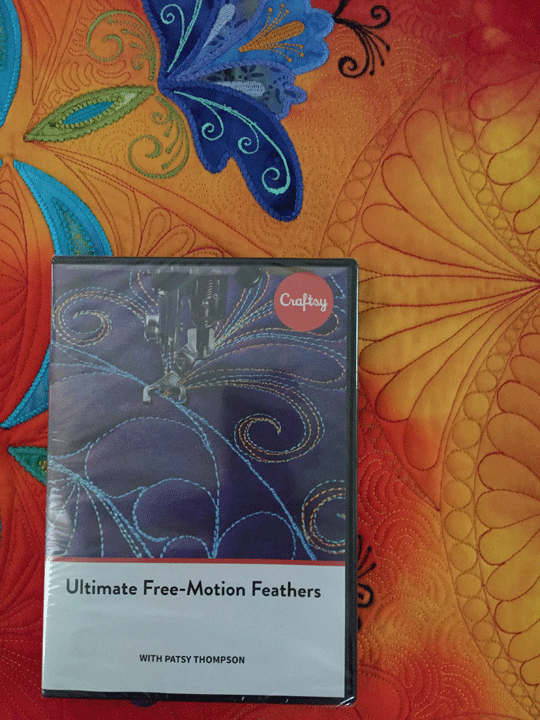 …and you can find it in our online store by clicking here. There’s a lot of feather info on this DVD that is not on any of my Free Motion Fun With Feathers DVD, so it’s worth it to check it out.
…and you can find it in our online store by clicking here. There’s a lot of feather info on this DVD that is not on any of my Free Motion Fun With Feathers DVD, so it’s worth it to check it out.
Filed under
Craftsy!, Free Motion Quilting, Machine Embroidered Applique, ruler work on a HDSM.
May 17th, 2017
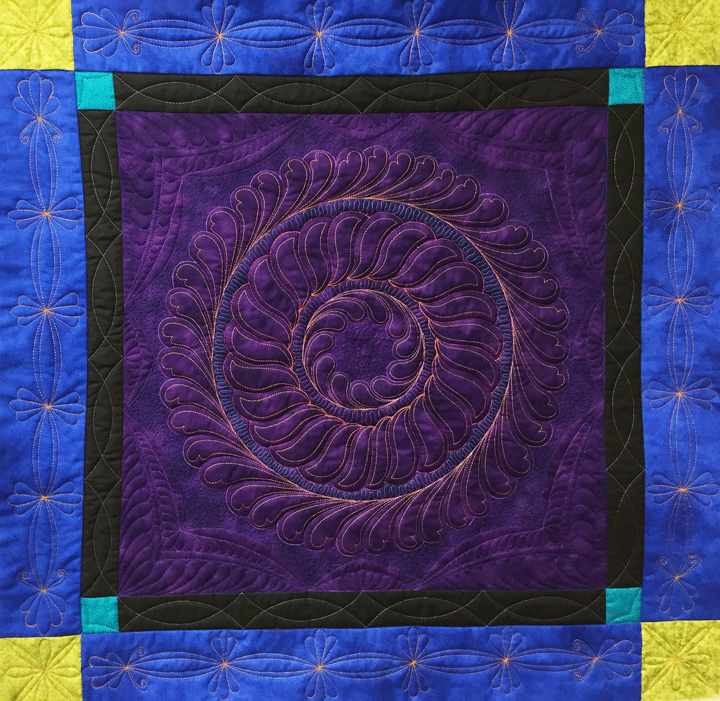 When you have an important motif (and that motif could be a quilted, appliqued, or pieced motif), you can frame it with your quilting design. The trapuntoed feathered wreath in the center block is important, and it’s been highlighted further through framing. Unfortunately, the overall size of my block didn’t leave me much room for framing, but there was enough room for a small frame design.
I began by using my original temporary marks that I used to create the trapuntoed section. The only thing new here, (and it’s hard to see), was that I added small tick marks 2 inches from either side of the short center lines:
When you have an important motif (and that motif could be a quilted, appliqued, or pieced motif), you can frame it with your quilting design. The trapuntoed feathered wreath in the center block is important, and it’s been highlighted further through framing. Unfortunately, the overall size of my block didn’t leave me much room for framing, but there was enough room for a small frame design.
I began by using my original temporary marks that I used to create the trapuntoed section. The only thing new here, (and it’s hard to see), was that I added small tick marks 2 inches from either side of the short center lines:
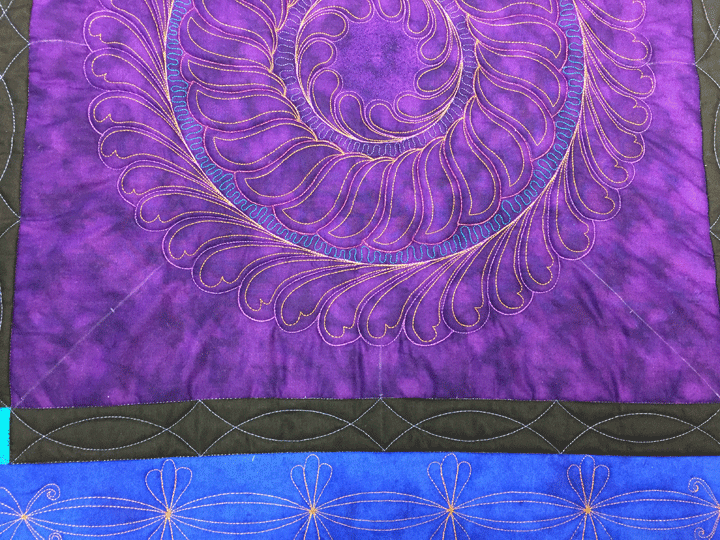 I used those marks as my starting/stopping points and then used my PTD 8 arc ruler and PTD 6.5 ruler to create the first round of framework:
I used those marks as my starting/stopping points and then used my PTD 8 arc ruler and PTD 6.5 ruler to create the first round of framework:
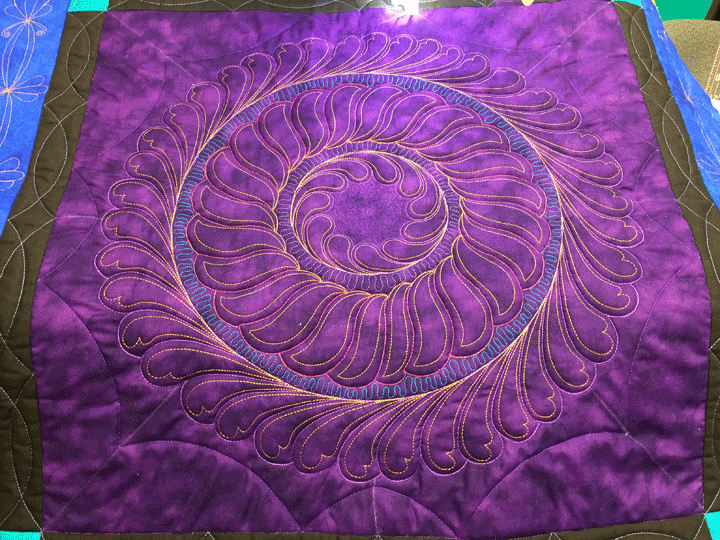 I then went back in with the PTD 12 arc to create tapered swags on the larger curves, and used the same PTD 6.5 arc on the small center arches to create a tapered swag:
I then went back in with the PTD 12 arc to create tapered swags on the larger curves, and used the same PTD 6.5 arc on the small center arches to create a tapered swag:
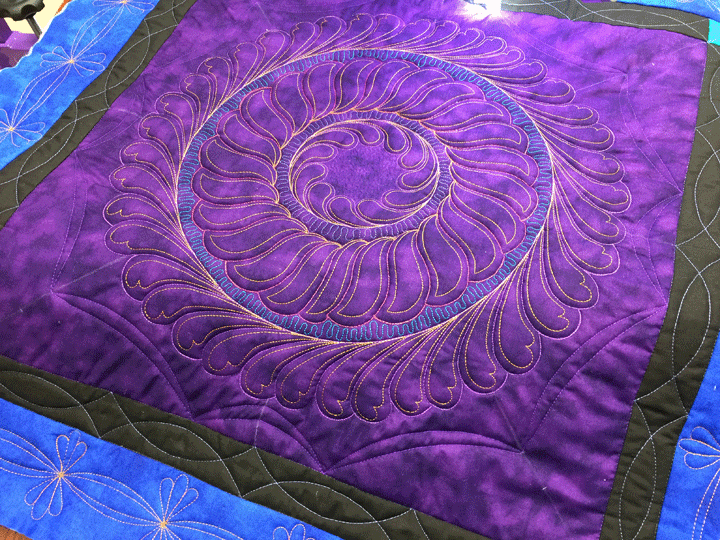 If you look closely at the long diagonal soap lines in the corners, you’ll see a small tick mark about 1 inch from the swag cleavage points. I used those tick marks as may new starting/stopping points and then took my Quilted Pineapple 22 arc ruler to add in another arc. Once that arc was stitched, I added a new tick mark 1/2 inches down further and then used the same ruler to create a channel:
If you look closely at the long diagonal soap lines in the corners, you’ll see a small tick mark about 1 inch from the swag cleavage points. I used those tick marks as may new starting/stopping points and then took my Quilted Pineapple 22 arc ruler to add in another arc. Once that arc was stitched, I added a new tick mark 1/2 inches down further and then used the same ruler to create a channel:
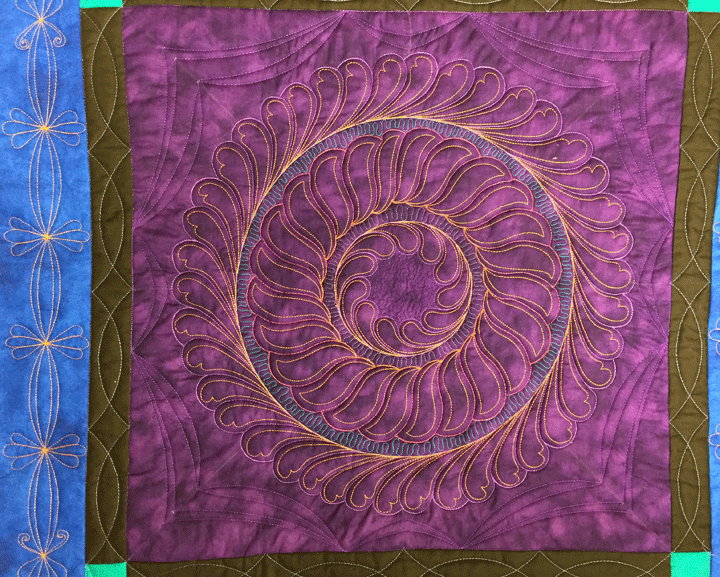 Now that all the ruler work framing has been finished, the fill in work begins. I first added featherettes inside the widest channels:
Now that all the ruler work framing has been finished, the fill in work begins. I first added featherettes inside the widest channels:
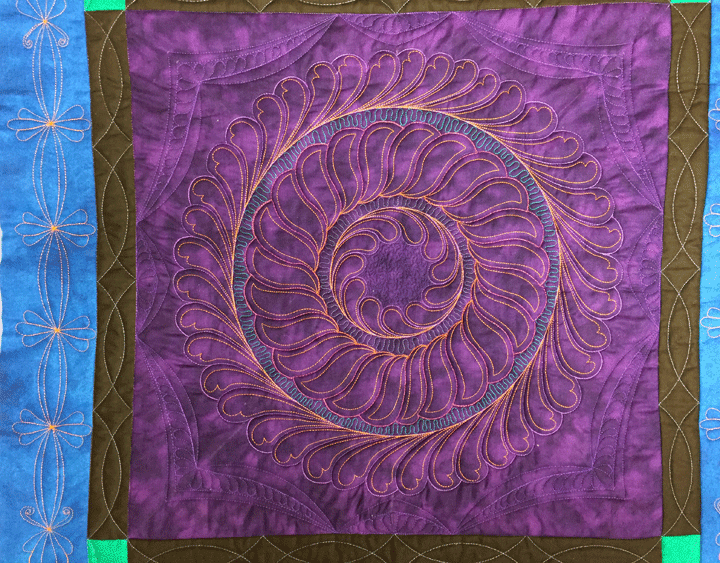 Next, I used a dark blue thread to stipple in the zone between the wreath and the frame. This will serve to highlight both the wreath and the frame:
Next, I used a dark blue thread to stipple in the zone between the wreath and the frame. This will serve to highlight both the wreath and the frame:
 Lastly, I added another featherette, stitched in the same dark blue polyester thread, in the remaining space between the block’s edge and the ruler work framework. Here is a shot of one corner as it is being stitched:
Lastly, I added another featherette, stitched in the same dark blue polyester thread, in the remaining space between the block’s edge and the ruler work framework. Here is a shot of one corner as it is being stitched:
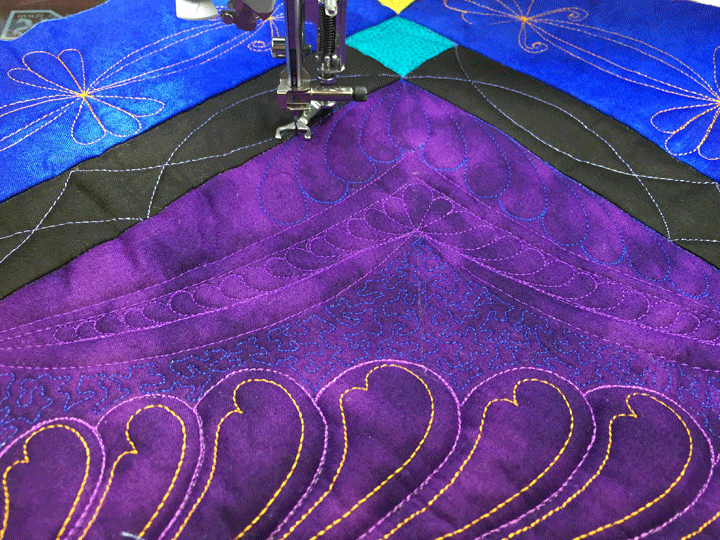 The goal in stitching these featherettes is to completely fill the empty space with the featherette. If you do that consistently, that will give the look of identical and mirror image featherettes. Of course, you are stitching everything freehand, so it is not identical at all, but it will give the illusion that it is. Here are some other shots:
The goal in stitching these featherettes is to completely fill the empty space with the featherette. If you do that consistently, that will give the look of identical and mirror image featherettes. Of course, you are stitching everything freehand, so it is not identical at all, but it will give the illusion that it is. Here are some other shots:
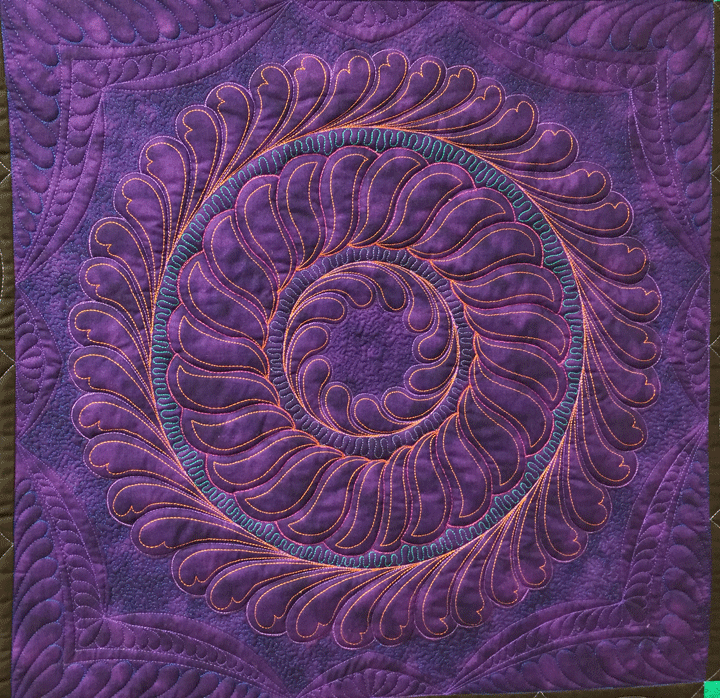 You can appreciate the texture better in tangential shots:
You can appreciate the texture better in tangential shots:
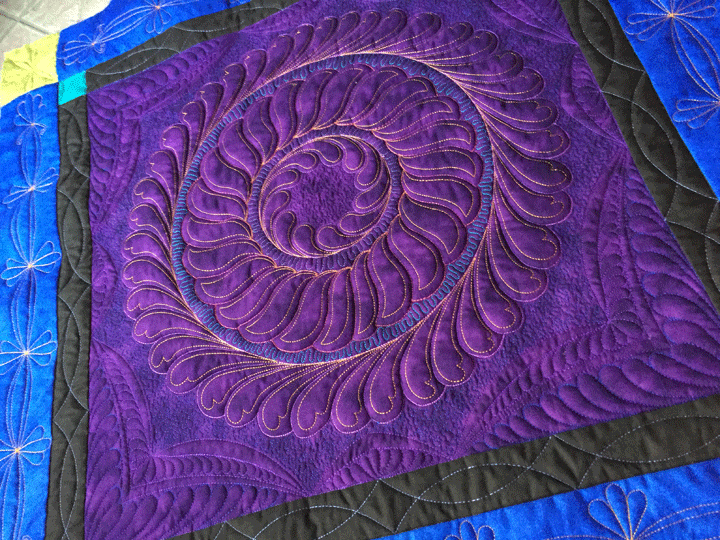 Learning to create custom featherettes to fill spaces on a quilt is a very, very useful skill to develop. If you are interested in learning more, this is an old blog post that talks about them a bit and you can find it by clicking here.
Learning to create custom featherettes to fill spaces on a quilt is a very, very useful skill to develop. If you are interested in learning more, this is an old blog post that talks about them a bit and you can find it by clicking here.
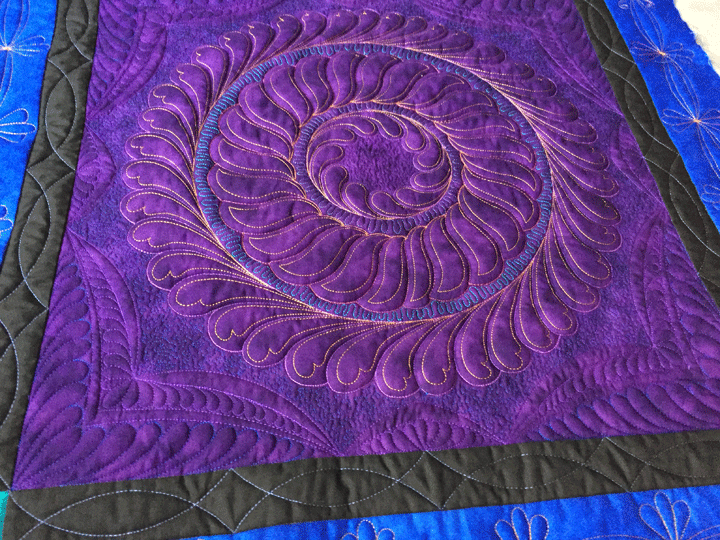 An even more in-depth instruction can be found in my Craftsy class called Ultimate Free Motion Feathers and you can find it by clicking here.
An even more in-depth instruction can be found in my Craftsy class called Ultimate Free Motion Feathers and you can find it by clicking here.

Filed under
Craftsy!, Free Motion Quilting, ruler work on a HDSM, Trapunto.
March 26th, 2017
 I heard from several people who wanted to know how I made this ruler work feathered wreath, so the tutorial that follows outlines the steps. When I set out to do something like this, I don’t have the full thing composed in my head, so I’m making up the wreath as I go. Sometimes I learn difficult lessons by working like this and other times the universe is smiling on me and everything works out great. The difficult lesson I learned on this one was that I should have started with a much larger fabric block! I started with a 20 in square block but wish I’d started with a 24-26 in square block. If you make this wreath, start larger and you can always trim it if you don’t want to do something with the surrounding zone.
Step 1: I used the PTD flower templates to create the center. I used all 3 templates, set in concentric flower format. You can see a short video of me doing that on my previous post by clicking here.
Step 2: At the end of step 1, here’s what I had:
I heard from several people who wanted to know how I made this ruler work feathered wreath, so the tutorial that follows outlines the steps. When I set out to do something like this, I don’t have the full thing composed in my head, so I’m making up the wreath as I go. Sometimes I learn difficult lessons by working like this and other times the universe is smiling on me and everything works out great. The difficult lesson I learned on this one was that I should have started with a much larger fabric block! I started with a 20 in square block but wish I’d started with a 24-26 in square block. If you make this wreath, start larger and you can always trim it if you don’t want to do something with the surrounding zone.
Step 1: I used the PTD flower templates to create the center. I used all 3 templates, set in concentric flower format. You can see a short video of me doing that on my previous post by clicking here.
Step 2: At the end of step 1, here’s what I had:
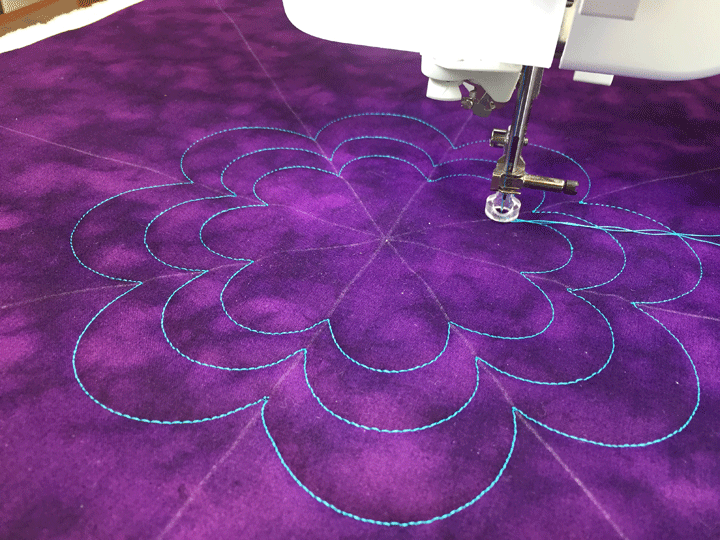 I knew I was making a feathered wreath that would be large and I wanted to have plumes on the inner portion as well as the outer portion. I also knew going in that my wreath would be large so I was “pushing it” as far as proportions go in having tiny plumes in the center and large plumes on the outside. This meant I needed to preserve the largest size of “inside circle” as possible, and when I say “inside circle,” I am referring to the circle from which the inside plumes would flow. I measured the maximal diameter from inside flower cleavage to the inside flower cleavage on the opposite side and it fell between 3 1/2 in-4 inches. This meant I would “waste” some space if I used my templates to draw a 3 1/2 in circle, so I instead used my Quilter’s Groove Pro Echo 4 arc ruler to stitch short arcs from each inside cleavage point to the next cleavage point. By working this way instead of using some form of a circle template, I could create the largest circle possible within that space. (I realize this might be confusing, but this is an important tip if you’re trying to use your rulers to “customize” a given design, so I’m putting it out there.) Here is what the wreath looked like at the end of this step:
I knew I was making a feathered wreath that would be large and I wanted to have plumes on the inner portion as well as the outer portion. I also knew going in that my wreath would be large so I was “pushing it” as far as proportions go in having tiny plumes in the center and large plumes on the outside. This meant I needed to preserve the largest size of “inside circle” as possible, and when I say “inside circle,” I am referring to the circle from which the inside plumes would flow. I measured the maximal diameter from inside flower cleavage to the inside flower cleavage on the opposite side and it fell between 3 1/2 in-4 inches. This meant I would “waste” some space if I used my templates to draw a 3 1/2 in circle, so I instead used my Quilter’s Groove Pro Echo 4 arc ruler to stitch short arcs from each inside cleavage point to the next cleavage point. By working this way instead of using some form of a circle template, I could create the largest circle possible within that space. (I realize this might be confusing, but this is an important tip if you’re trying to use your rulers to “customize” a given design, so I’m putting it out there.) Here is what the wreath looked like at the end of this step:
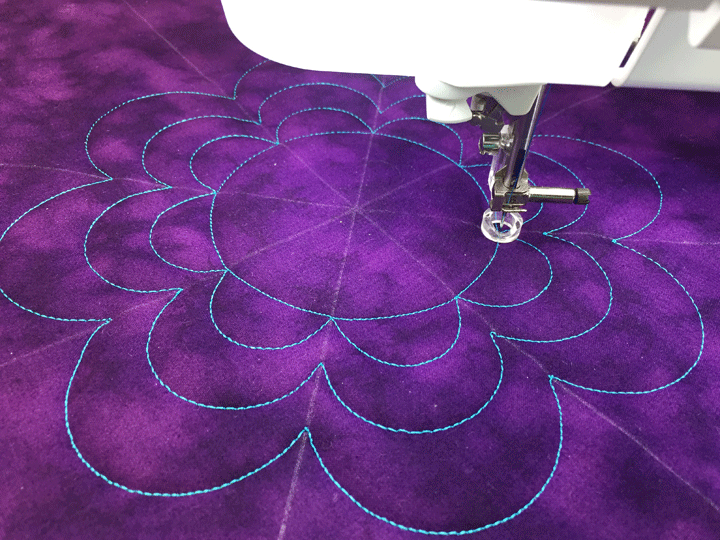 Step 3: Next up, I wanted to stitch the remaining circles that would be in this wreath. By working in this way, I am establishing the boundaries of the “negative space” within the wreath that I would be able to play in for the fill-in work. I used my Westalee Circles on Quilts Template set and stitched the 10 1/2 and 11 1/2 in circles. How did I choose those sizes of circles? I was “locked into” a maximal wreath size because of what I had chosen as my starting fabric block size, so I worked backwards. I figured that after allowing for enough space to throw plumes around the outside circle, that fabric block could not tolerate a large circle more than 11 1/2 inches, so that was my maximal circle size. I also knew I wanted to throw a ring of pearls around the outermost border of the circle, so I knew I needed a 10 1/2 inner circle as this would give me a 1/2 in diameter channel. Here’s what the wreath looked like at this point in the process:
Step 3: Next up, I wanted to stitch the remaining circles that would be in this wreath. By working in this way, I am establishing the boundaries of the “negative space” within the wreath that I would be able to play in for the fill-in work. I used my Westalee Circles on Quilts Template set and stitched the 10 1/2 and 11 1/2 in circles. How did I choose those sizes of circles? I was “locked into” a maximal wreath size because of what I had chosen as my starting fabric block size, so I worked backwards. I figured that after allowing for enough space to throw plumes around the outside circle, that fabric block could not tolerate a large circle more than 11 1/2 inches, so that was my maximal circle size. I also knew I wanted to throw a ring of pearls around the outermost border of the circle, so I knew I needed a 10 1/2 inner circle as this would give me a 1/2 in diameter channel. Here’s what the wreath looked like at this point in the process:
 Step 4: This is the beginning of creating fill-in designs in that “negative space” area. I changed thread colors and used my PTD 8 arc ruler to create small inward curving arcs all along the outermost flower petals. There are markings etched on the flower petals that delineate the middle of each petal, so that’s where those small tick marks shown below came from. The original soap lines that I drew on the fabric block are the other intersections that I used as my starting and stopping points to do this ruler work. If this is confusing, check out the in-process photo below:
Step 4: This is the beginning of creating fill-in designs in that “negative space” area. I changed thread colors and used my PTD 8 arc ruler to create small inward curving arcs all along the outermost flower petals. There are markings etched on the flower petals that delineate the middle of each petal, so that’s where those small tick marks shown below came from. The original soap lines that I drew on the fabric block are the other intersections that I used as my starting and stopping points to do this ruler work. If this is confusing, check out the in-process photo below:
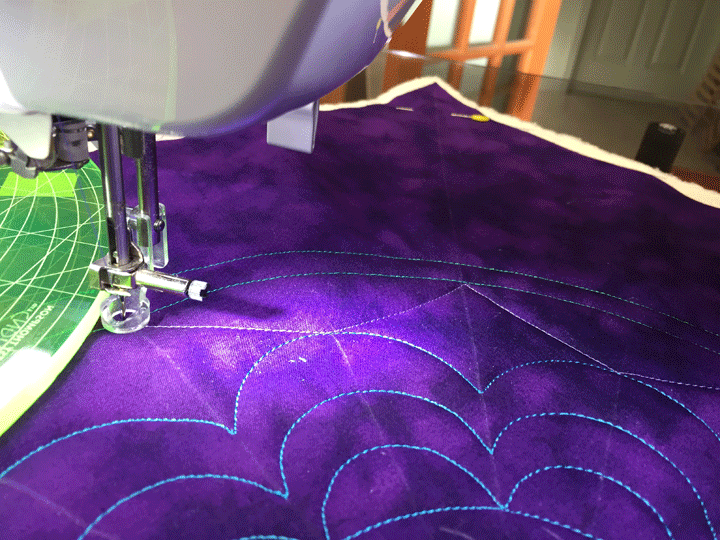 I used the same PTD ruler to add a tapered channel to my diamonds, then added small featherettes inside the smallest flower petals and also added the innermost plumes, and here is what it looked like at the end of this section:
I used the same PTD ruler to add a tapered channel to my diamonds, then added small featherettes inside the smallest flower petals and also added the innermost plumes, and here is what it looked like at the end of this section:
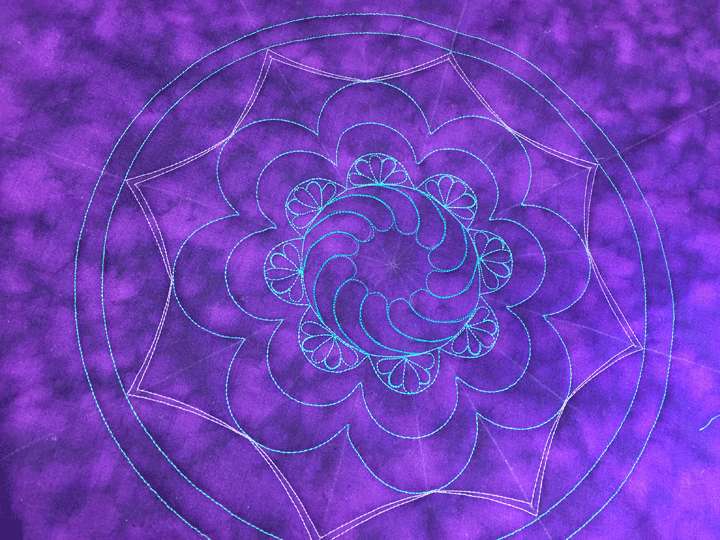 Before we move on to the next section, a couple of things:
1. Anytime I am filling a space with a featherette, I start by stitching that center-most plume, then I keep reflecting off what has been stitched to fill each side. I usually have a soap line that runs down the center of the space to help me keep things centered.
2. I know of 2 ways to create the plumes on a feathered wreath. You can take a stencil that flows from roughly the same size circle and trace the plumes to follow, or you can stitch the plumes freehand. I will show you how to stitch the plumes freehand when we do the outermost plumes in step 8. I took the easy way out on the inner plumes and traced them from a stencil.
Step 5: I swapped thread colors again, then I added Aztec featherettes inside the small diamonds. Here’s how the wreath looked at the end of this step:
Before we move on to the next section, a couple of things:
1. Anytime I am filling a space with a featherette, I start by stitching that center-most plume, then I keep reflecting off what has been stitched to fill each side. I usually have a soap line that runs down the center of the space to help me keep things centered.
2. I know of 2 ways to create the plumes on a feathered wreath. You can take a stencil that flows from roughly the same size circle and trace the plumes to follow, or you can stitch the plumes freehand. I will show you how to stitch the plumes freehand when we do the outermost plumes in step 8. I took the easy way out on the inner plumes and traced them from a stencil.
Step 5: I swapped thread colors again, then I added Aztec featherettes inside the small diamonds. Here’s how the wreath looked at the end of this step:
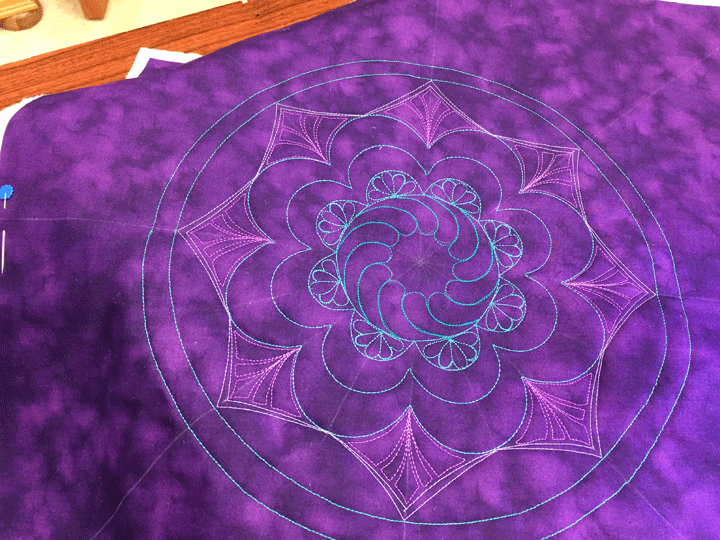 Step 6: I swapped thread colors again and added featherettes into the largest size petal areas. Notice that each time I have filled a zone with featherettes, I have changed some or all of the plume shapes that comprise the featherettes. This is deliberate as it will make the wreath more interesting. Here is what the wreath looked like at this stage:
Step 6: I swapped thread colors again and added featherettes into the largest size petal areas. Notice that each time I have filled a zone with featherettes, I have changed some or all of the plume shapes that comprise the featherettes. This is deliberate as it will make the wreath more interesting. Here is what the wreath looked like at this stage:
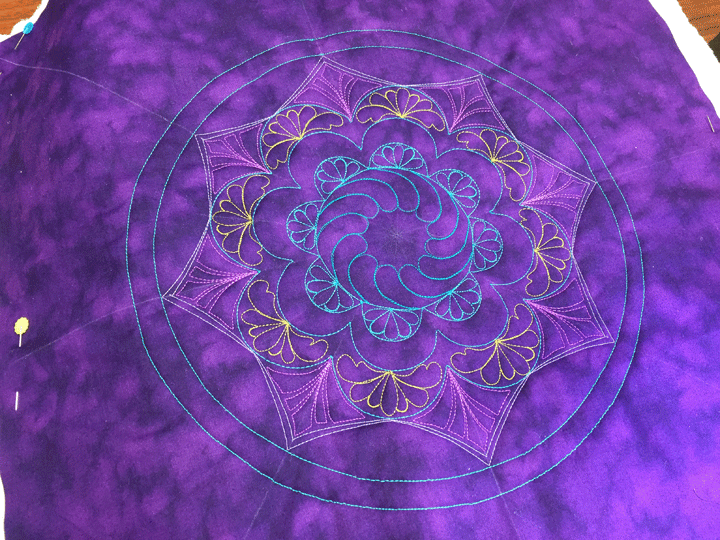 Step 7: I swapped thread colors again and filled the remaining negative space that bordered the external circles with the figur-of-8’s fill design. This design always works well if you need to fill a dynamic space, or one whose height is changing. The only trick to it is that you want to keep the design perpendicular to the base of the space you are filling. Here’s what the wreath looked like at this point:
Step 7: I swapped thread colors again and filled the remaining negative space that bordered the external circles with the figur-of-8’s fill design. This design always works well if you need to fill a dynamic space, or one whose height is changing. The only trick to it is that you want to keep the design perpendicular to the base of the space you are filling. Here’s what the wreath looked like at this point:
 Step8: I wanted to add the plumes to my wreath before I went any farther in the inside. Here is how I add freehand plumes to a feathered wreath:
-using soap or other temporary marker, draw a temporary circle around your outermost circle that will be your “boundary line,” or the target for the outermost plunge of each plume. If you deliberately stretch each plume to hit that boundary line, your plume size will be symmetric across the wreath. I used my compass to make this and literally spread its span to the widest diameter possible.
-To stitch your plumes, you will begin with a “hook,” then add each plume using the bump-back feather technique. By using that specific technique, your plume shapes have the best chance of being as uniform as possible. This next shot is early in the process of adding my plumes to that outer-most circle. If you look to the far right, you can see my beginning “hook shape,” and if you look along the outer edge of the plumes, you can see my soap line circle that I’m using for my boundary mark:
Step8: I wanted to add the plumes to my wreath before I went any farther in the inside. Here is how I add freehand plumes to a feathered wreath:
-using soap or other temporary marker, draw a temporary circle around your outermost circle that will be your “boundary line,” or the target for the outermost plunge of each plume. If you deliberately stretch each plume to hit that boundary line, your plume size will be symmetric across the wreath. I used my compass to make this and literally spread its span to the widest diameter possible.
-To stitch your plumes, you will begin with a “hook,” then add each plume using the bump-back feather technique. By using that specific technique, your plume shapes have the best chance of being as uniform as possible. This next shot is early in the process of adding my plumes to that outer-most circle. If you look to the far right, you can see my beginning “hook shape,” and if you look along the outer edge of the plumes, you can see my soap line circle that I’m using for my boundary mark:
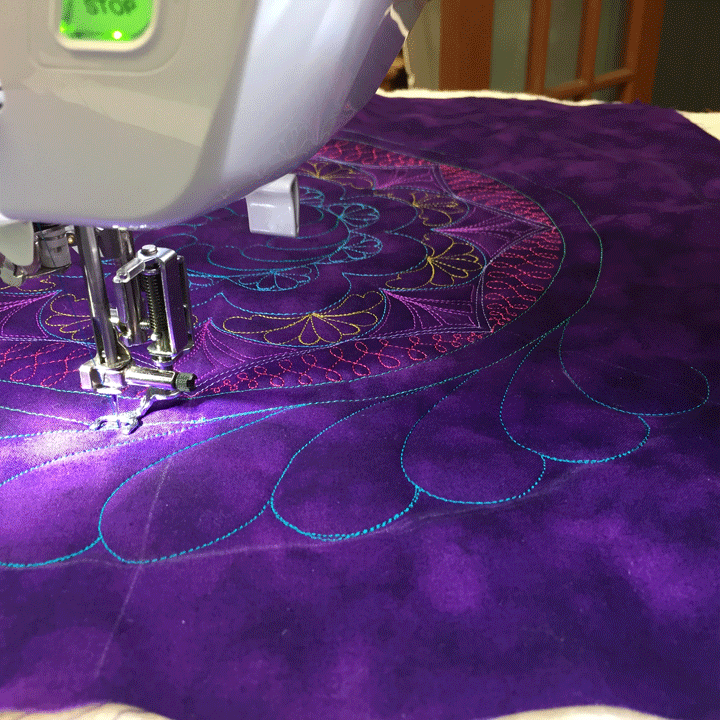 For me, this next part of the process is the most gut-wrenching! I keep adding my plumes until I have enough space left for the last 4-5 plumes. I then remove the quilt from the machine and lay it out to look at what space is left. I go ahead and draw the remaining plumes, taking care that the final plume will have a reasonable “meet up” with the original hook. I don’t have to follow my drawing exactly as I stitch, but it gives me an assurance that things will all work out in the end. Here’s a shot of what this looked like before i took it back to the machine for the final plumes:
For me, this next part of the process is the most gut-wrenching! I keep adding my plumes until I have enough space left for the last 4-5 plumes. I then remove the quilt from the machine and lay it out to look at what space is left. I go ahead and draw the remaining plumes, taking care that the final plume will have a reasonable “meet up” with the original hook. I don’t have to follow my drawing exactly as I stitch, but it gives me an assurance that things will all work out in the end. Here’s a shot of what this looked like before i took it back to the machine for the final plumes:
 This next shot is what the wreath looks like once all plumes have been added. I want you to look carefully at the plumes so you will see that they are not all uniform. They really aren’t, but they are close enough that the wreath registers as “believable” and the wreath is beautiful. I’m telling you this because we are all way too tough on ourselves as quilting critics and we need to get over it!!!
This next shot is what the wreath looks like once all plumes have been added. I want you to look carefully at the plumes so you will see that they are not all uniform. They really aren’t, but they are close enough that the wreath registers as “believable” and the wreath is beautiful. I’m telling you this because we are all way too tough on ourselves as quilting critics and we need to get over it!!!
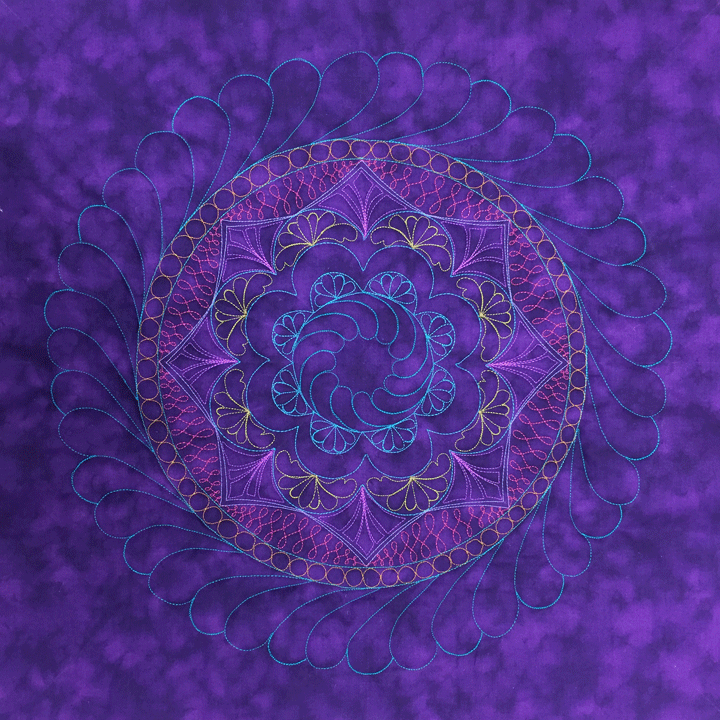 Step 9: I swapped to a gold polyester thread and hyperquilted those Aztec featherettes, then used the same thread to quilt a row of pearls inside the outermost circle. Here’s what it looked like at this point:
Step 9: I swapped to a gold polyester thread and hyperquilted those Aztec featherettes, then used the same thread to quilt a row of pearls inside the outermost circle. Here’s what it looked like at this point:
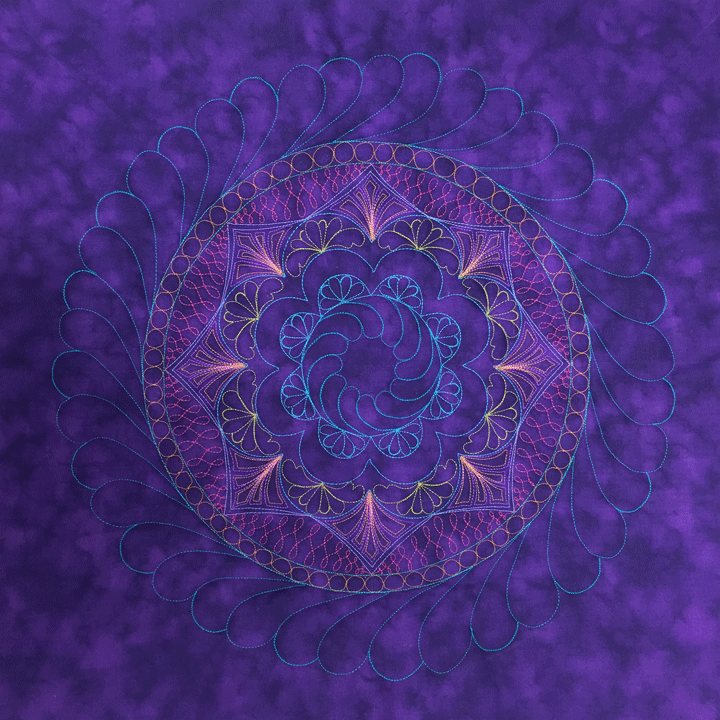 Final step 10: I hyperquilted the outermost plumes with the same gold thread, using a compound hyperquilting design that merged a swirl with splay lines. The innermost plumes were hyperquilted with simple in-lining. And here is the end result:
Final step 10: I hyperquilted the outermost plumes with the same gold thread, using a compound hyperquilting design that merged a swirl with splay lines. The innermost plumes were hyperquilted with simple in-lining. And here is the end result:
 …and a closeup:
…and a closeup:
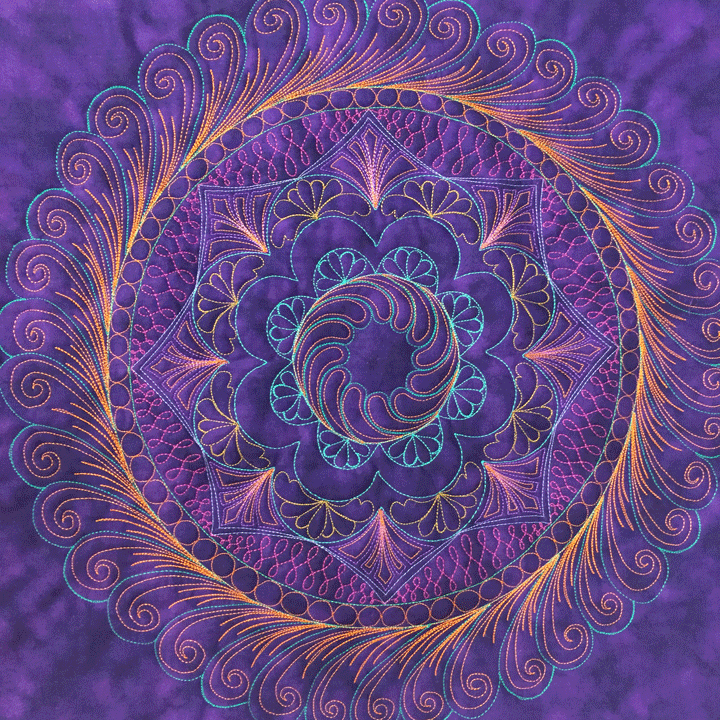 This was a very fun way spend a day and I’m glad I did it! This was actually stitched as a trapunto layer, so it’s not done. I will hopefully be able to return to it soon and whenever that happens, I’ll post with some in process photos again. In the meantime, if you are wanting to learn more about featherettes and feathers, check out my Craftsy class called Ultimate Free Motion Feathers!
This was a very fun way spend a day and I’m glad I did it! This was actually stitched as a trapunto layer, so it’s not done. I will hopefully be able to return to it soon and whenever that happens, I’ll post with some in process photos again. In the meantime, if you are wanting to learn more about featherettes and feathers, check out my Craftsy class called Ultimate Free Motion Feathers!
Filed under
Craftsy!, Free Motion Quilting, ruler work on a HDSM, Trapunto.
September 24th, 2016
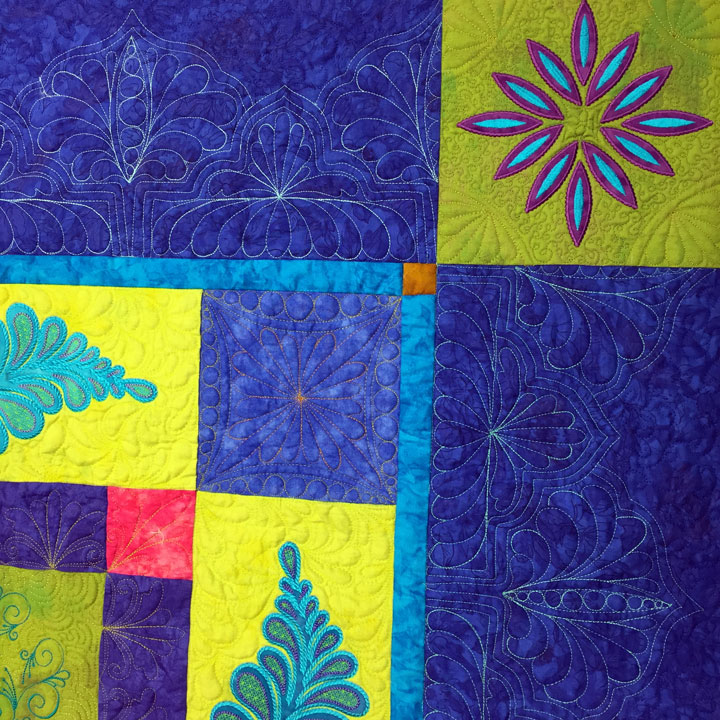
I am not a person to leave things to the last minute. I am that jerk you went to school with who finished her report 3 days early “just in case” a dog might chew it up at the last minute! This is the 2nd time in my life where I’ve entered a quilt into a quilt show that wasn’t already completed and now I am paying for it BIG TIME! I am racing against the clock to get the quilting done by Mon am but I also need to bind it, label it, and get the dang hanging sleeve added!
The outermost border has a lot of ruler work followed by fill in work. Here’s a section of empty ruler work:
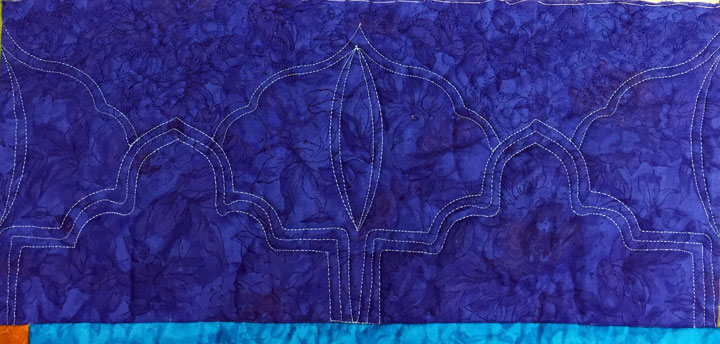
The lowest tier is from the Turrets 2 ruler. The upper tier is from the Turrets 1 ruler, and then the crescents are from 2 arc rulers (PTD 8 and 12 arcs.) You can see that I am so pressed for time that I am “settling” for sub-par work on my part, but that’s the price I must pay for being so late in getting this done. In this next shot, you can see what the turrets 1 section looks like filled in:
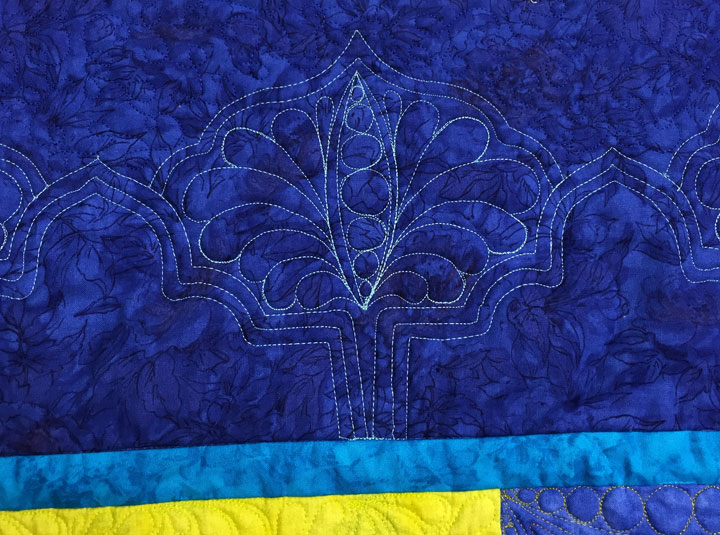
…and here’s a bit more fill in inside the Turrets 2 section:
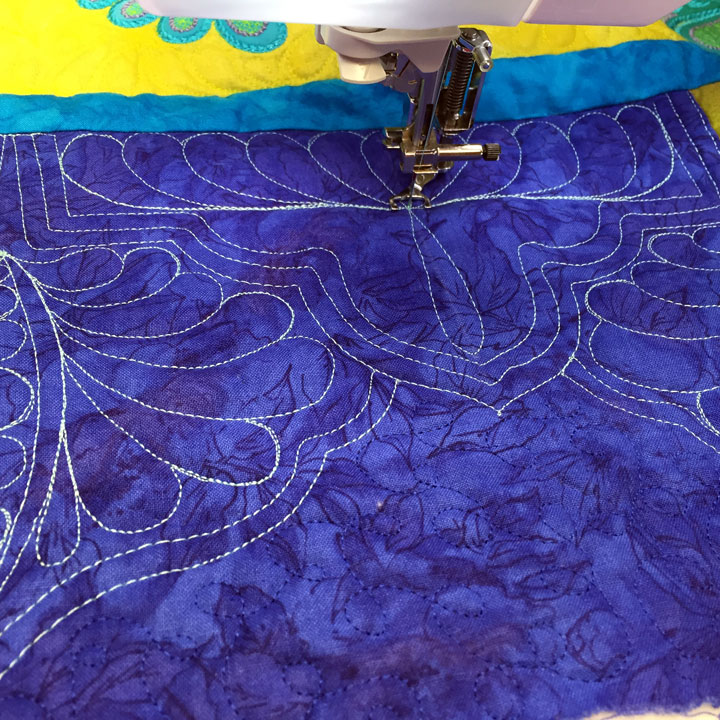
I have to say that filling these in with featherettes is pretty fun. I am seeing featherettes everywhere lately! This next shot shows both the Turrets 1 and Turrets 2 sections filled in:

I don’t actually like the look of these but it’s too late to rip out and move to something else. I am hoping there is time to hyperquilt them as I think that might make them a bit more enticing.
In the meantime, did you know that Craftsy is having a humongous sale?!! All classes are under $20 this weekend! How can you miss with a deal like that?! Follow this link to pick up a class a this great price. There are tons of great classes at Craftsy on all kinds of topics, so load up on them now and watch them at your leisure. If you’re interested in learning any of my techniques, be sure to check out my 2 classes, called Ultimate Free Motion Feathers and Ultimate Free Motion Quilting.

Filed under
Craftsy!, Free Motion Quilting, ruler work on a HDSM.
April 22nd, 2016
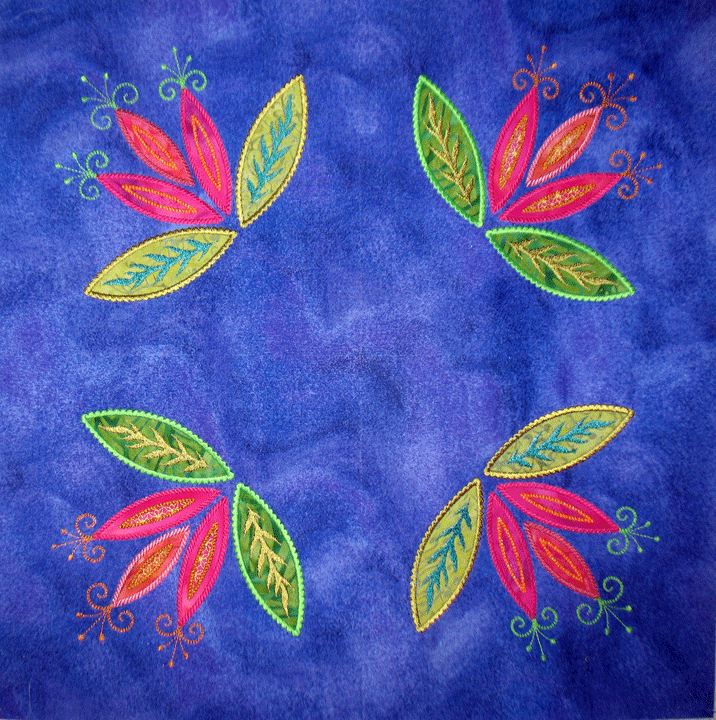 Thanks to everyone who participated in the drawing; I learned a lot about what people are interested in. The winner of the $25 gift certificate to our online store is:
Nancy Runnels-comment #18: “I am a beginner FMQ on my Janome 7700 QCP and I love it. I am curious about George and would welcome the class. Living in Virginia I could manage the travel. I enjoy moving the quilts and regularly do king size on my machine now. I am looking to be more refined and detail on quilting.
Thanks to everyone who participated in the drawing; I learned a lot about what people are interested in. The winner of the $25 gift certificate to our online store is:
Nancy Runnels-comment #18: “I am a beginner FMQ on my Janome 7700 QCP and I love it. I am curious about George and would welcome the class. Living in Virginia I could manage the travel. I enjoy moving the quilts and regularly do king size on my machine now. I am looking to be more refined and detail on quilting.
Thanks for the opportunity to learn.”
Congratulations, Nancy!
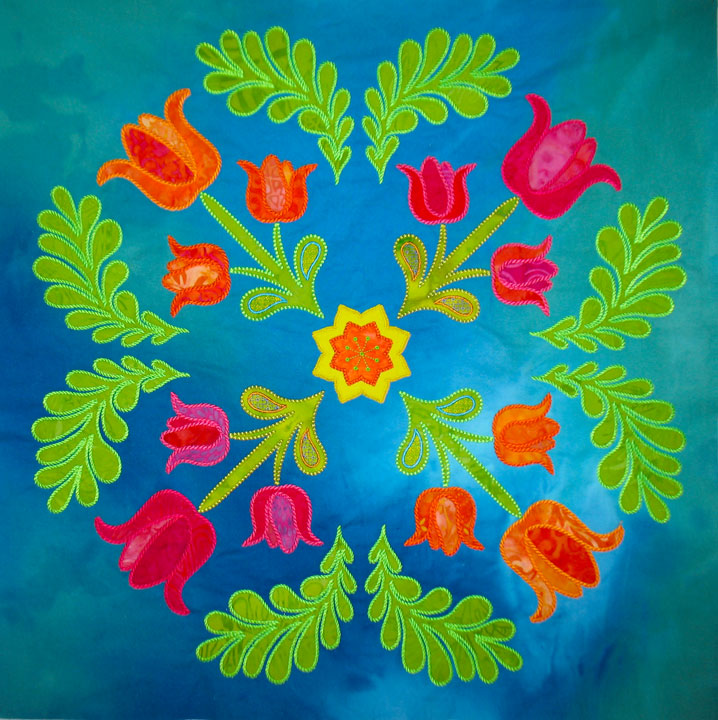 It is so nice to see trees in bloom and flowers opening up-spring has officially arrived! Craftsy is celebrating with a great sale on their classes; sale prices are 50% off the normal class price! Instead of spring cleaning, why not pick up a class or two to learn some new techniques? If you click on my affiliate link here to get the discount, I’ll receive a small “tip” for referring you. In the meantime, enjoy the sights and sounds of springtime!
It is so nice to see trees in bloom and flowers opening up-spring has officially arrived! Craftsy is celebrating with a great sale on their classes; sale prices are 50% off the normal class price! Instead of spring cleaning, why not pick up a class or two to learn some new techniques? If you click on my affiliate link here to get the discount, I’ll receive a small “tip” for referring you. In the meantime, enjoy the sights and sounds of springtime!
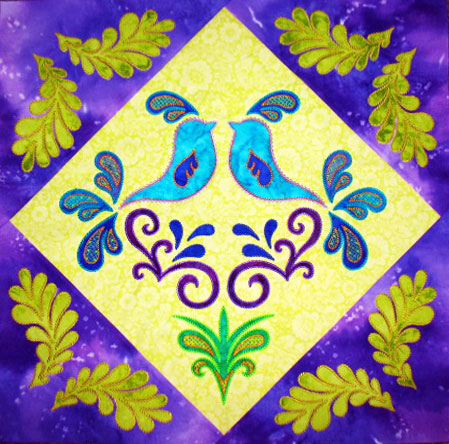
Filed under
Craftsy!, Store Updates.
 I made this table runner last week. It is actually made from a border design I made about a year ago and I’ve meant to adapt it into a table runner all these months but never got around to it. It’s a machine embroidery applique design and it’s nice because it takes about 35 minutes to stitch each fern so you can get a fair amount of other sewing work done while it’s stitching out. I’m not sure that the layout is quite right, though. I normally verify that my applique shape placement is aesthetically pleasing by stitching a mock-up of the placement outlines of applique shapes onto muslin, but I skipped that step. This is another one of those “don’t do it” moments when you have to painfully re-learn that there’s a good reason for most of one’s “double-checking” routines! I am in the process of making a revised version of this with a slight variation in the placement of the ferns. I’ll post a side-by-side comparison in a couple weeks once it’s done.
I made this table runner last week. It is actually made from a border design I made about a year ago and I’ve meant to adapt it into a table runner all these months but never got around to it. It’s a machine embroidery applique design and it’s nice because it takes about 35 minutes to stitch each fern so you can get a fair amount of other sewing work done while it’s stitching out. I’m not sure that the layout is quite right, though. I normally verify that my applique shape placement is aesthetically pleasing by stitching a mock-up of the placement outlines of applique shapes onto muslin, but I skipped that step. This is another one of those “don’t do it” moments when you have to painfully re-learn that there’s a good reason for most of one’s “double-checking” routines! I am in the process of making a revised version of this with a slight variation in the placement of the ferns. I’ll post a side-by-side comparison in a couple weeks once it’s done.
 This was very fun to quilt and that part was very quick. I used my PTD12 arc ruler to do the ruler work framing. The fill-in is featherettes and the goal is to completely “use up” the available space within the ruler work framework. The photos below show my strategy for doing this. In this next shot, you can see that I have horizontal/vertical lines denoting my center point and axes. Here is the first “quadrant” of the featherette being stitched using those guidelines:
This was very fun to quilt and that part was very quick. I used my PTD12 arc ruler to do the ruler work framing. The fill-in is featherettes and the goal is to completely “use up” the available space within the ruler work framework. The photos below show my strategy for doing this. In this next shot, you can see that I have horizontal/vertical lines denoting my center point and axes. Here is the first “quadrant” of the featherette being stitched using those guidelines:
 …and here the first “quadrant” of the featherette has been stitched and I’m moving on the the adjacent “quadrant” of the featherette:
…and here the first “quadrant” of the featherette has been stitched and I’m moving on the the adjacent “quadrant” of the featherette:
 Here’s an example of the center featherette once it’s been stitched:
Here’s an example of the center featherette once it’s been stitched:
 The space between the ruler work design and the fern appliques is filled by stitching plumes that stretch from the ruler work to just next to the applique shapes. Even though these plumes keep changing size/proportion, it works visually and you “believe” the end design:
The space between the ruler work design and the fern appliques is filled by stitching plumes that stretch from the ruler work to just next to the applique shapes. Even though these plumes keep changing size/proportion, it works visually and you “believe” the end design:
 I use that same “bump-back” method to fill the 1/2 inch channel by the edges of the table runner with a long, skinny featherette:
I use that same “bump-back” method to fill the 1/2 inch channel by the edges of the table runner with a long, skinny featherette:
 These featherettes are all made using the bump-back feather method. If you’re interested in how to create featherettes, I wrote a nice blog post explaining it awhile back and you can find it by clicking here. Alternately, you can learn about how to quilt featherettes in my Craftsy class. We are now selling the DVD for my Craftsy class called “Ultimate Free Motion Feathers:”
These featherettes are all made using the bump-back feather method. If you’re interested in how to create featherettes, I wrote a nice blog post explaining it awhile back and you can find it by clicking here. Alternately, you can learn about how to quilt featherettes in my Craftsy class. We are now selling the DVD for my Craftsy class called “Ultimate Free Motion Feathers:”
 …and you can find it in our online store by clicking here. There’s a lot of feather info on this DVD that is not on any of my Free Motion Fun With Feathers DVD, so it’s worth it to check it out.
…and you can find it in our online store by clicking here. There’s a lot of feather info on this DVD that is not on any of my Free Motion Fun With Feathers DVD, so it’s worth it to check it out.



































